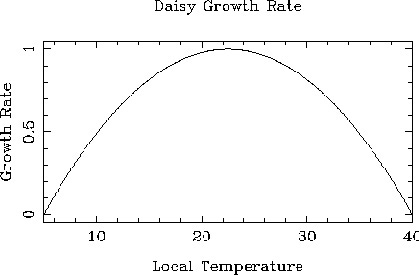
Paleoclimates eGuide
VIRTUAL RESEARCH INSTRUCTIONS
THE GAIA HYPOTHESIS: EXPLORING DAISYWORLD
The Gaia hypothesis states that the Earth's biosphere interacts with and regulates the physical conditions of the planet. This dynamic "geophysiology" is illustrated by Daisyworld, a planet in which the Earth;s surface is modeled in terms of its (blackbody) temperature, with black and white "daisies" living on the surface within a narrow range of temperatures (see graph below). Temperature is determined by incoming solar radiation and the color of the daisies locally covering Daisyworld's surface. Black daisies absorb light and heat the surface; white daisies reflect light and cool the surface. As Daisyworld evolves, the two sets of daisies germinate and die at different rates, altering local temperatures. Over a specific range of solar luminosities, the daisies steer the planetary system to a stable temperature range matching that required for optimal daisy growth ("homeostasis"). This is demonstrated in the following animation:
DAISYWORLD Flash Animation: http://library.thinkquest.org/C003763/flash/gaia1.htm
Thus, Daisyworld explains how the Earth's temperature remained close to the range required for life to exist even while solar luminosity apparently increased significantly over geological timescales (60% up to today's 100%). Since the original Daisyworld was proposed, many complexities have been added to the model; today, an enthusiastic, cross-disciplinary scientific community (http://www.cogs.susx.ac.uk/daisyworld/index.html) continues to experiment with the model.
The basic geophysiological feedbacks of "Daisyworld" can be illustrated with a bare surface albedo a0 covered by white daisies with albedo a1>a0 and black daisies with albedo a2<a0. When exposed to the solar radiation, these three albedos affect different local temperatures over fractional areas covered by daisies and bare surface. Daisy growth rates depend only on temperature: below 5şC above 40şC they will not grow.

The global albedo of Daisyworld is controlled by the growth of the daisies; this causes global temperature to change, which in turn affects the daisy growth rates, leading to homeostasis. External perturbations, e.g., an increasing solar luminosity (60% to 140% of current 343 W/m² to simulate solar evolution over geological time), effects from increased biodiversity potentials, or from changes in atmospheric mixing to simulate greenhouse gas effects, cause other interesting behaviors in Daisyworld. [Java-enabled Web Browser]
DIRECTIONS:
With Java-and popup-enabled Internet Explorer, go to: http://gingerbooth.com/courseware/daisy.html.
Click "run" to run the default model described above. Click on the "questions" button to access Lab Daisyworld to fully explore the model.